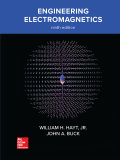
Concept explainers
Point charges of equal magnitude but of opposite sign are positioned the charge +q at z = -d/2 and charge -q at z= -d/2 The charges in this configuration form an e1ectric dispole (a) Find the electric field intensity E everywhere on the z-axis is (b) Evaluate pan a result at the origin
(c) Find the electric geld intensity everywhere on the zy plane, expressing your result as a function of radius p in cylindrical coordinates, (d) Evaluate your pan c result at the origin (e) Simplify your part c result for the case in which p >> d.
(a)
The electric field intensity on z -axis.
Answer to Problem 2.7P
The required electric field intensity is:
Explanation of Solution
Given Information:
The point charge
Calculation:
Let
Conclusion:
The required electric field intensity is:
(b)
The electric field intensity at origin.
Answer to Problem 2.7P
The required electric field intensity is,
Explanation of Solution
Given Information:
The point charge
Calculation:
The electric field at origin,
Conclusion:
The required electric field intensity is
(c)
The electric field intensity on x-y plane as a function of radius in cylindrical coordinates.
Answer to Problem 2.7P
The required electric field intensity is
Explanation of Solution
Given Information:
The point charge
Calculation:
Let
Conclusion:
The required electric field intensity is
(d)
The electric field intensity at origin.
Answer to Problem 2.7P
The required electric field intensity is
Explanation of Solution
Given Information:
The point charge
Calculation:
The electric field intensity at origin,
Conclusion:
The required electric field intensity is
(e)
The electric field intensity on x-y plane when
Answer to Problem 2.7P
The required electric field intensity is,
Explanation of Solution
Given Information:
The point charge
Calculation:
When
Conclusion:
The required electric field intensity is
Want to see more full solutions like this?
Chapter 2 Solutions
Engineering Electromagnetics
- 2. ẞ 100, VBE(on)= 0.7 V, and VCE(sat) = 0.2 V for the BJT. We want to find the Q-point through the following steps. Show your work. a) Find the bias voltage VTH Using Thevenin's equivalent circuit. R1|| R2 www +5 V R₁ = 20 k IB VTH Answer: VTH = V b) Find the base current voltage IB. www. Answer: IB = μA (note the unit.) c) Find the collector voltage Vc (with reference to the ground). RC= 2.3 k B E R₂ = 30 k -5 V www R₁ = 5 ΚΩ ww AHI› RE= 5 ΚΩarrow_forward3. Consider the circuit, in which R₁ = 10 KQ2, R2 = 5 KQ, R3 = 1 KQ, and RE = 8 KQ. The supply voltages are +Vcc = 10 V and -VEE = -5 V. Other parameters are ẞF = 100, VBE(On) = 0.7 V, and VCE(Sat) 0.2 V. Rc value will be specified later. (a) (3 points) Draw the dc equivalent circuit of the circuit. VI +Vcc Rc R2 RI R₁ RE -VEE υο R3 (b) Find the Thevenin equivalent voltage source VEQ and input resistance REQ of the DC equivalent circuit. Show your work. +Vcc Rc UC VEQ www REQ VE VEQ = REQ = ΚΩ RE VEEarrow_forwardThe solution is with a pen and paper. Really not smartarrow_forward
- 1. Consider the following mechanical system. Obtain the differential equation model for the system. Write the transfer function of the system also. Note here, input u(t) is force and output x(t) is the displacement of the mass. x (Output) k1 k2 www u(t) m (Input force) No frictionarrow_forwardNO AI PLEASEarrow_forward2. Consider the following mechanical system with two masses. Find the differential equation model for the system. Find the transfer functions X1(s) and U(s) Note, in the figure, x₁ and x2 are displacements and u is the force. X2(s) U(s) also. k₁ www + b₁ " x1 k2 kz www mi www m2 Đ b₂arrow_forward
- 4. Find the transfer function H(s) = = Vo(s) V₁(s) for the following circuit. Vi R₁ ww A R₂ ww Voarrow_forwardAnswer the following questions. Take help from ChatGPT to answer these questions (if you need). But write the answers briefly using your own words with no more than two sentences and make sure you check whether ChatGPT is giving you the appropriate answers in our context. A) Write Newton’s second law of motion. B) What is a dashpot? C) What is Hooke’s law? Why there is a negative sign? D) Write the voltage and current equation for an Ideal Op-amp.arrow_forward3. Find the differential Equation model for the following electrical circuit. Write the transfer function also. Here, input u(t) is a current source and output y(t) is the current through the resistor R. u(t) (I) 州 BRarrow_forward
 Introductory Circuit Analysis (13th Edition)Electrical EngineeringISBN:9780133923605Author:Robert L. BoylestadPublisher:PEARSON
Introductory Circuit Analysis (13th Edition)Electrical EngineeringISBN:9780133923605Author:Robert L. BoylestadPublisher:PEARSON Delmar's Standard Textbook Of ElectricityElectrical EngineeringISBN:9781337900348Author:Stephen L. HermanPublisher:Cengage Learning
Delmar's Standard Textbook Of ElectricityElectrical EngineeringISBN:9781337900348Author:Stephen L. HermanPublisher:Cengage Learning Programmable Logic ControllersElectrical EngineeringISBN:9780073373843Author:Frank D. PetruzellaPublisher:McGraw-Hill Education
Programmable Logic ControllersElectrical EngineeringISBN:9780073373843Author:Frank D. PetruzellaPublisher:McGraw-Hill Education Fundamentals of Electric CircuitsElectrical EngineeringISBN:9780078028229Author:Charles K Alexander, Matthew SadikuPublisher:McGraw-Hill Education
Fundamentals of Electric CircuitsElectrical EngineeringISBN:9780078028229Author:Charles K Alexander, Matthew SadikuPublisher:McGraw-Hill Education Electric Circuits. (11th Edition)Electrical EngineeringISBN:9780134746968Author:James W. Nilsson, Susan RiedelPublisher:PEARSON
Electric Circuits. (11th Edition)Electrical EngineeringISBN:9780134746968Author:James W. Nilsson, Susan RiedelPublisher:PEARSON Engineering ElectromagneticsElectrical EngineeringISBN:9780078028151Author:Hayt, William H. (william Hart), Jr, BUCK, John A.Publisher:Mcgraw-hill Education,
Engineering ElectromagneticsElectrical EngineeringISBN:9780078028151Author:Hayt, William H. (william Hart), Jr, BUCK, John A.Publisher:Mcgraw-hill Education,





